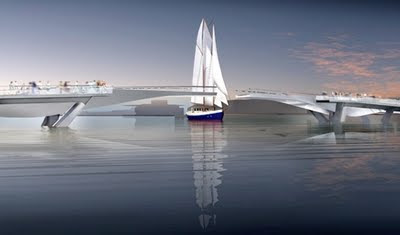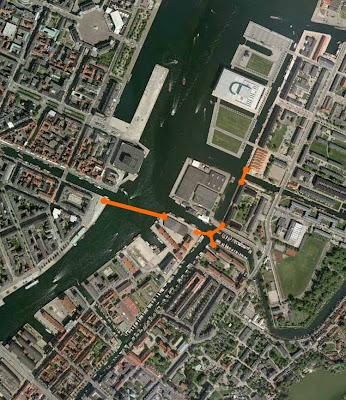

The winning design for a new bicycle bridge over Copenhagen’s Inner Harbour.The current efforts of the city of Copenhagen to encourage more citizens to choose the bicycle have given us a lot of new, exciting infrastructure, not least in the form of bridges. Now there are four new bridges on the way exclusively for bicycles and pedestrians.
For example above, at left, is Åbuen, a bicycle/pedestrian bridge over the busy Å Boulevard which is part of the Green Path bicycle motorway. At right is Bryggebroen, the bridge over the harbour from the Vesterbro neighbourhood to Iceland Quay. The latter features almost 10,000 cyclists a day and that's expected to increase when the infrastructure link to the existing bicycle lanes is completed on the north side.There are, of course, main bridges over the harbour. Langebro and Knippels Bridge both have over 20,000 cyclists a day each on the bike lanes parallel to the car lanes but the two bicycle/pedestrian bridges pictured above have created increased mobility and short cuts for bicycles and shortened travel times by bike for thousands and thousands of cyclists.
The harbour was decommercialized a decade or so ago and the city is now revitalizing this newly-won real estate. The harbour is cleaned up and Copenhageners now swim in it. It really has changed the face of the city this harbour liberation.
Earlier this year The City of Copenhagen launched a invitation only design competition for a network of new bicyle/pedestrian bridges over the ancient harbour of the city and the winners were announced last month. What the city needs is access across the harbour farther east, closer to the city centre on the Inner Harbour. Our new Opera and the former military area called Holmen, which now features the National Film School, School of Architecture, National Theatre School and others, as well as new flats would benefit greatly from increased access.As you can see on the map, a network of bridges is needed. A long bridge over the inner harbour and shorter bridges over some of the canals to link up the places mentioned above.This being Copenhagen, a bicycle bridge was the first and only thought. Funnily, in the Danish press the bridges are almost always referred to as 'bicycle bridges' even though we all know they are for pedestrians, too. Such is the status and role of the bicycle in this city. Call it a 'pedestrian bridge' and it sounds recreational - something you promenade on. Call it a 'bicycle bridge' and suddenly everyone gets it. They think commuting, quicker route to work, shorter travel time, etc.The Inner Harbour Bridge
 The jury of the design competition ended up selecting different winners. One for the long section over the harbour and another for the short canal bridges. Here's the winning entry for the Inner Harbour Bridge from the consortium of Flint & Neill and Studio Bednarski.A Danish journalist was quick to dub it The Kissing Bridge and the name seems to be sticking. It's a rare form of bridge in that it is retractable - as opposed to a swing bridge or a drawbridge. It looks like two tongues reaching out for each other.
The bridge is 180 m. long, with decks that are 7 m. wide and it opens for ships with a sliding mechanism, allowing for a 50 m. wide opening.The jury was unanimous in choosing The Kissing Bridge as the winner. They said, among other things:
The jury of the design competition ended up selecting different winners. One for the long section over the harbour and another for the short canal bridges. Here's the winning entry for the Inner Harbour Bridge from the consortium of Flint & Neill and Studio Bednarski.A Danish journalist was quick to dub it The Kissing Bridge and the name seems to be sticking. It's a rare form of bridge in that it is retractable - as opposed to a swing bridge or a drawbridge. It looks like two tongues reaching out for each other.
The bridge is 180 m. long, with decks that are 7 m. wide and it opens for ships with a sliding mechanism, allowing for a 50 m. wide opening.The jury was unanimous in choosing The Kissing Bridge as the winner. They said, among other things:
"... a compelling overall concept and an attractive design that will help form the identity of the site in the future. This horizontal span into the harbour space is beautifully conceived and magical in use. The bridge forms a horizontal movement that is both figuratively and physically dependent on the use of the bridge and on the perceptions of its beholders, a movement that strengthens identification of the horizontal aspect of the harbour space as it is today."
The Canal Bridges
 The winning design for the Canal Bridges was won by WTM with Dietmar Feichtinger Architects.The jury's conclusion included these words:
The winning design for the Canal Bridges was won by WTM with Dietmar Feichtinger Architects.The jury's conclusion included these words:
"The lightness of the bridge design seems very well founded in the urban context, with its apparent connection with the simplicity we would normally associate with landing stages in harbours. It's an exemplary natural expression in a minimalist functionality. The idiom is so small in scale that there is no hint of monumentality whatsoever, in complete contrast to the urban landscape, but in this way it adapts itself in the best possible way to the contextual whole."
There are many high-masted sailboats in the canals so these bridges have to be openable as well. And praising this design by saying "no hint of monumentality whatsoever" really speaks volumes about the Danish design culture and tradition. We don't fancy monumentality. We want elegance and functionality, thank you very much.The bridges are expected to be completed by Spring 2012.The full Jury report about the finalists is availabe as a pdf on The City of Copenhagen's website for the architecture-minded among us. You can see the other finalists as well, including some world-class architects. As architecture competitions go, the Danish tradition of transparency applies here as well. You can see how many points the bids got, what the jury thought and really feel as though you're part of the selection process. Not at all secretive or elitist. Refreshing, really.








